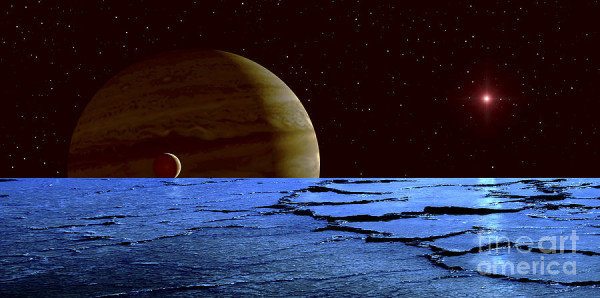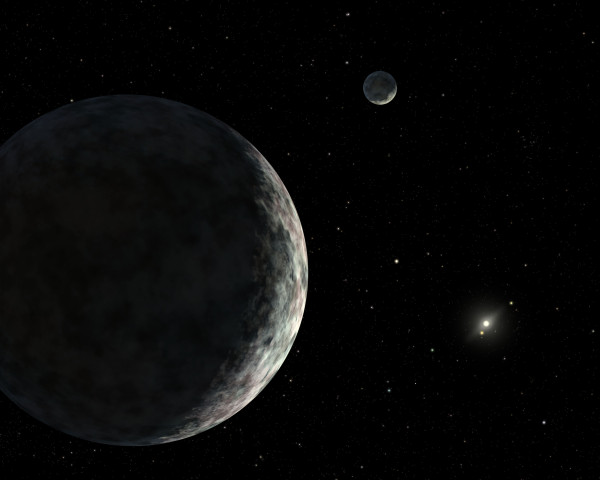“What was scattered, gathers.
What was gathered, blows away.” -Heraclitus
When you're looking around in our Solar System, we've got the Sun at the center, the planets orbiting them, and then moons orbiting the planets in turn.
But why is that necessarily the limit? Couldn't we have "moonlets" or some other, smaller satellites orbiting the moons?
 Image credit: Frank Hettick / Fine Art America, via http://fineartamerica.com/featured/jupiter-and-its-moon-lo-as-seen-fran….
Image credit: Frank Hettick / Fine Art America, via http://fineartamerica.com/featured/jupiter-and-its-moon-lo-as-seen-fran….
It seems like there's no reason that shouldn't be the case, but yet we don't yet know of any in the Solar System. Is there a reason we don't have any, or do we fully suspect they're out there, waiting to be discovered?
 Image credit: Robert Hurt (IPAC), via http://solarsystem.nasa.gov/planets/profile.cfm?Object=KBOs.
Image credit: Robert Hurt (IPAC), via http://solarsystem.nasa.gov/planets/profile.cfm?Object=KBOs.

If you're calling the celestial objects that orbit moons 'moons' too, then obviously you have a definition of moon that doesn't require 'circles a planet' as part of the definition. But once you get rid of that constraint, then we already have moons of moons, because then the solar system's planets count as moons of the Sun, and thus their moons are 'moons of moons,' and you would be forced to retitle your post 'Can moons of moons have moons?' OTOH if you say no that doesn't count, only things that circle planets count as moons, then you can't have moons of moons by definition. :)
Then of course there's the question of whether your definition of moon includes only 'natural' bodies and for how long something has to orbit another body in a stable orbit for it to count as a moon. If you don't mind artificial things counting, then arguably Kaguya/SELENE (2007-2009) was a moon of a moon. Now AFAIK we haven't put any satellite permanently in orbit around a moon, but AIUI that's because we don't want to (we intentionally crashed Kaguya at the end of its mission), not because the orbital physics makes such satellite-of-satellite systems hard or impossible to produce.
So whether there are moons of moons brings us back to how you want to define moon...a question of Plutonic proportions... :)
Quoting Wikipedia, which is quoting (I think) the IAU, "A natural satellite or moon is a celestial body that orbits another body (a planet, dwarf planet, or small Solar System body), which is called its primary, and that is not artificial."
This definition doesn't preclude a moon of a moon, but as Ethan pointed out, we don't yet have any examples of this, and the dynamics are such that it is probably unlikely.
@eric
I'm actually fascinated by this:
https://en.wikipedia.org/wiki/Claimed_moons_of_Earth
Apparently we can have quasi-satellites like the asteroid Cruithne, which isn't a satellite and isn't a trojan. Is it a quasi-moon? Was or is Pluto a quasi-moon of Neptune? Can a planet or dwarf planet be a quasi-moon? If so can't it also be moon?
Then there are temporary satellites like 2006 RH120. It is natural, so it's a temporary moon, but shouldn't then also Phobos be called so, since we know it won't stay there in the long run? Should there be a minimal amount of time or orbits for natural bodies to be called moons? Or shouldn't they simply be called moons while they are orbiting? If so it is not impossible that even our Moon once harbored some moons for a little while, and might do so again in the future. Being a moon isn't such a clear cut business after all...
"Was or is Pluto a quasi-moon of Neptune?"
Probably not, most likely a captured KBO that was pulled into an orbit by Neptune.
"Can a planet or dwarf planet be a quasi-moon? If so can’t it also be moon?"
No, because the classifications preclude something occupying both types.
"No, because the classifications preclude something occupying both types."
Can't see it. Please provide evidence that a dwarf planet can't also be a quasi-moon. I'm going with this definition of quasi-moon: https://en.wikipedia.org/wiki/Quasi-satellite.
If i put Ceres in the right orbit close to Neptune or Uranus what are you going to call it?
Well look, then.
No longer in the asteroid belt, therefore not an asteroid.
But as to
Ignoring, for a start, that you are calling a quasi-satellite here a quasi-moon, ergo not a quasi-satellite and therefore misspoken, and that your original query was
therefore ceres is a red herring:
Pluto is not orbiting the same orbital period as Neptune and therefore is not a quasi-satellite.
If we address “Can a planet be a quasi-moon? If so can’t it also be moon?” it is again not a moon unless it orbits a planet, not the sun.
"or dwarf planet" could be, but there isn't a change: it is still a dwarf planet.
Arcibald: probably your best example of how the issue is partially about definition is Phobos (and its little sibling moon, Diemos). They're both irregular in shape, being too small to pull themselves spherical, both likely are captured asteroids, and one is expected to crash into Mars while the other flies away...eventually. So if they count as moons (they do), then shouldn't other small irregularly shaped temporarily orbiting objects count as moons? And if not, where do we draw the line?
I suppose it doesn't matter, as Ethan's primary point is that such systems are difficult to make stable over the long term, and therefore given humanity's small temporal 'window' on the solar system, it would be unlikely that we'd see any. This is true regardless of what we call them; we might see some unstable configurations if we are lucky, but we're unlikely to see any long-term stable ones.
As for the former, I might put my money on Io and Triton. They're both volcanically active and Io has a very small escape velocity. If some detritus from an eruption gets enough energy that it circles the planet once..twice...three times....at one point do we call it a satellite of that moon?
Oops, circles the moon, of course...that being the point of the entire article. :)
@wow
#4: "No, because the classifications preclude something occupying both types."
#7: "could be, but there isn’t a change: it is still a dwarf planet."
I'll let your double personality disorder settle this one...
Well, you could let your double personality which sees double all the time sort it out.
You could let your outer moron which can't work out what you want to talk about discuss with itself why it wants to talk about moons being planets and use them apparently interchangeably.
Or you could not believe that planets can be moons at the same time, just as #4 and #7 say.
You know, if you want to be sane about things.
If not, then go hog wild, dearie.
Maybe, baldie, your problem is you don't know what a moon is or a planet is, therefore you think that when you talk about moons you can call them planets and swap them about as you like.
The sane proportion of the universe would like to have words used for their meaning, rather than made up on the spot.
But like I said, you can go hog wild if you like, but nobody is going to give a damn about your confusion when it's entirely self-inflicted on you.
We have not found any natural satellites of satellites in the solar system. We do see three-level hierarchial systems among stars, with a binary orbiting a star that itself orbits another star, but this generally involves much greater distances and higher masses than one finds with planets and moons. The addition of the third potential to the Hill problem (the Sun, in the case of the Earth-Moon system) generally causes the eccentricity of the tertiary satellite orbit to evolve to an escape or collisional state. For some systems, there may be a fairly narrow combination of eccentricity, inclination and period allowing a third level orbit to persist for long times. In the limited number of bodies in the solar system (and our incomplete inventory of such) nature hasn't found such orbits, but an artificial satellite might be placed in one, at least in accordance with some recent articles.